A small faint equatorial constellation between Leo and Hydra. The sextant is very faint, with only two stars brighter than 5 mag. Good thing there are brighter constellations nearby. The Sextant lies roughly in a triangle whose vertices are formed by the bright stars Alfard, Denebola and Regulus. The constellation is located in a rich region of galaxies, and despite its relatively small size, contains a larger number of them. The most beautiful of these is the remarkably elongated NGC 3115.
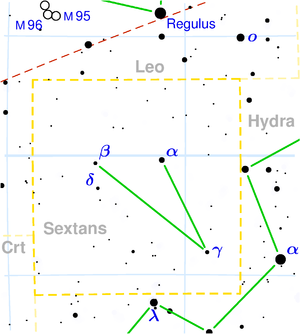
α Sex - The brightest star of the constellation has an apparent magnitude of 4.5. It is located almost exactly on the celestial equator. It is located 270 light-years away.
35 Sex - nice pair of orange 6.3 magnitude and yellow-orange components of 7.4 magnitude, which can be easily distinguished even in a small amateur telescope. Their separation is 6.8".
17 a 18 Sex - A wide pair of unrelated stars that can be identified with the naked eye if the observer has good vision. They are easily separated with a telescope. They have magnitudes of 5.9 and 5.6. The components are separated by 530 and 470 light-years.
Struve 1441 - A tight, attractive pair that can be resolved with a telescope with an objective diameter of around 100mm at a separation of 2.6". The brighter orange component has a magnitude of 6.4, while the fainter blue component has a magnitude of 9.9.
NGC 3115
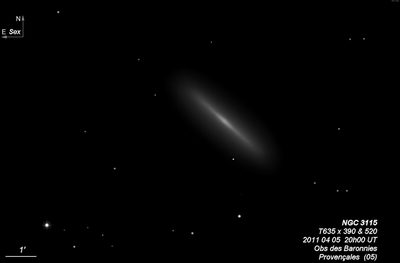
William Herschel discovered NGC 3115 = H I-163 = h668 = h3223 on 22 Feb 1787 (sweep 704) and recorded "eB, cL, mE 45° sp to nf. The bright part about 2' long with vF branches extending in all, to 4 or 5'." On 14 Mar 1828 (sweep 136), John Herschel wrote, "vB; L; mE; vsmbM; almost to a nucl; 3' l, 30" br. With 12-inches aperture, its nucleus is rather speckled; with 6-inch it is barely discernible as a neb."
NGC 3115 was first observed by Lord Rosse on 11 Mar 1848 (one of the earliest observations). In 1861, Lord Rosse's observer questioned if "Is Nucl. resolvable and oblong?"
200/250mm - 8" (3/24/84): very bright, high surface brightness, very bright core.
300/350mm - 13.1" (3/24/84): stunning edge-on, very bright, small very bright core.
400/500mm - 17.5" (1/31/87): very bright, fairly large, edge-on spindle 3:1 SW-NE, 5.5'x1.8'. Unusually high surface brightness, bright core, stellar nucleus. A mag 12.5 star is 3.2' S of center and a mag 10.5 star is 8' E. MCG -01-26-021 lies 17' SSE.
900/1200mm - 48" (2/19/12): this showpiece galaxy was stunning at 287x and 375x, with a very high surface brightness halo, ~5.5'x2', which is punctuated by a brilliant, nearly stellar nucleus. The nucleus is centered within an extremely bright, very flattened core extending 1'-1.5'. This dazzling streak dims slightly outside the central region but stretches at least 2.5' along the major axis with no breaks or significant drops in surface brightness. The view of this thin, super-luminous central disc bisecting most of the outer, elongated halo was a unique sight.
UGCA 200, a faint dwarf galaxy, lies 5.7' SE. At 375x it appeared as a faint low surface brightness patch with averted vision, slightly elongated NNW-SSE, with no central concentration. The galaxy is situated within a triangle formed by a mag 11.2 star 1.7' SE, a mag 15.3 star 1.5' NW and a mag 13.8 star 2' ENE.
Notes by Steve Gottlieb
NGC 3169
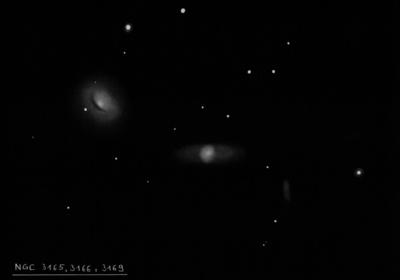
William Herschel discovered NGC 3169 = H I-4 = h684, along with NGC 3166, on 19 Dec 1783 (early sweep 58). His summary description from 4 sweeps reads "cB, pL, cometic, mbM." He published a sketch in his 1811 paper (Fig. 22) as an illlustration of "nebulae that have a cometic appearance." John Herschel also made 4 observations, logging on 13 Feb 1826 (sweep 18): "B; R; gmbM; 60"; the foll of 2."
Édouard Stephan published accurate positions for NGC 3166 and 3169 from 18 Mar 1884 in his 13th list (#56 and 57), though he misidentified the galaxies as NGC 3165 and NGC 3166. R.J. Mitchell observed ths galaxy on 15 Mar 1855 with LdR's 72" and commented "sharp at sf edge [dust lane?] and fades of np, spreading out in that direction." The following January he also noted "perhaps vF neby beyond the well defined sf edge?"
300/350mm - 13" (4/16/83): bright, bright core.
400/500mm - 17.5" (3/23/85): bright, slightly elongated SW-NE, moderate concentration, pretty faint stellar nucleus. A mag 11 star is just off the east side, 1.6' from the center. Third of three with NGC 3166 7.8' WSW and NGC 3165 12' SW.
Notes by Steve Gottlieb
NGC 3166
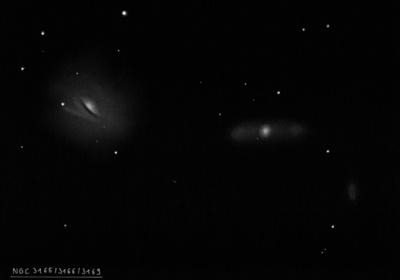
William Herschel discovered NGC 3166 = H I-3 = h684, along with NGC 3169, on 19 Dec 1783 (early sweep 58). His summary description from 4 sweeps reads "cB, pL, cometic, mbM." John Herschel made 4 observations. John Herschel's first of four observations was on 13 Feb 1826 (sweep 18): "B; R; gbM; 60". The preceding of 2 [with NGC 3169]."
Édouard Stephan's observation on 18 Mar 1884, which was published in list XIII-56, is within a few arcseconds of NGC 3166 though Dreyer and Esmiol (who later re-reduced all of Stephan's positions) misidentify this entry as NGC 3165. Also Stephan's XIII-57 refers to NGC 3169, though he calls it NGC 3166 in the notes section to list XIII.
300/350mm - 13" (4/16/83): fairly bright, bright core. Forms a pair with NGC 3169.
400/500mm - 17.5" (3/23/85): bright, almost round, even concentration to a brighter core and stellar nucleus (large, low surface brightness arms not seen). The core appears brighter than NGC 3169 7.8' ENE but the duo is pretty similar. Second of three with NGC 3165 4.6' SW. Two mag 12.5 stars lie 2.6' NW and 2.8' SW of center.
Notes by Steve Gottlieb
UGC 5373
400/500mm - 17.5" (2/1/03): This dwarf irregular galaxy probably lies just outside the local group (4.3 million l.y.) in a small group that includes NGC 3109, Sextans A and the Antlia Dwarf. Picked up without difficulty at 100x, 8' NE of mag 7.7 SAO 118040 (middle of three on a line with two mag 11 stars). At 140x, Sextans B appeared as a large, oval glow, elongated 3:2 WNW-ESE, ~3.5'x2.2', with a low surface brightness and broad, weak concentration. The surface seems slightly irregular or mottled and four fainter stars are near the periphery. This galaxy was surprisingly easy though I had never searched for it before.
900/1200mm - 48" (4/18/15): Sextans B is a nearby dwarf galaxy, generally considered to lie just outside the local group in a small group (including Sextans A). It appeared as a large, fairly low surface brightness oval glow, extending 4:3 WNW-ESE, ~2.6'x1.9'. It exhibits a broad weak concentration to a slightly brighter middle, but there is no distinct core or zones. The surface brightness is irregular and slightly clumpy. A mag 14.5 star is at the north edge of the galaxy and a mag 15 star is off the southeast edge of the galaxy.
A young (2 ? 1 billion years) massive globular cluster (SDSS J100004.63+052007.5) was discovered in 2007 in Sextans B using the HST WFPC2 and verified at the Special Astrophysical Observatory in Russia. At V = 17.9 it appeared as an extremely faint "star" and was visible only intermittently, though repeatedly confirmed at the same position. This object is located ~1.2' ENE of the center of Sextans B, close to the east edge of the galaxy.
Notes by Steve Gottlieb
NGC 3023
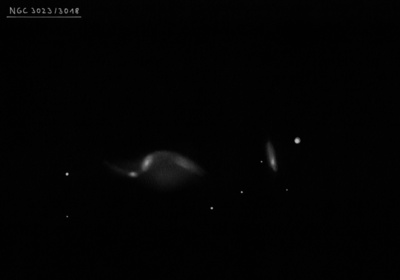
Édouard Stephan discovered NGC 3023 = St. X-22 on 10 Mar 1880, along with NGC 3018 = St. X-21, and measured an accurate position. Lewis Swift independently discovered the galaxy exactly 6 years later with the 16" refractor, but his position for Sw. III-49 is 0.4 min too far west (similar offset as Sw. III-48 = NGC 3018).
400/500mm - 17.5" (2/8/91): fairly faint, fairly small, slightly elongated 4:3, broad concentration in halo but no nucleus. A faint star or knot is visible on the east end. Forms a pair with NGC 3018 3' W and also 3.4' ESE of a mag 10 star. This is a double system which was probably resolved in the observation as a faint star or knot on the east end (Mrk 1236)!
900/1200mm - 48" (4/7/13): at 375x appeared very bright, large, irregular, asymmetric with a bright, slightly elongated central region, ~40"x30". Extending to the west of the core is large, faint halo or loop, most evident on the north side of the loop, which is brighter and more sharply defined as it sweeps to the west towards companion NGC 3018. The loop extends the diameter to ~1.7'. Mrk 1236, is a very small, but very high surface brightness companion attached on the east side of the core. LEDA 1170217 = MAC 0950+0035 was picked up in the field, 4.4' ESE. It appeared faint (V = 16.6), small, slightly elongated, 15"x10", low even surface brightness.
48" (4/2/11): at 375x this bright, interacting galaxy has a very unusual, asymmetric appearance. The central region is bright, oval 4:3 NNW-SSE, 40"x30", increases evenly to a very small, very bright nucleus. A larger, outer halo extends mainly to the west. The halo extends from the central region ~1' in a loop and is brightest along the rim, particularly looping from the north side of the core counterclockwise to the west [the DSS reveals this feature is a spiral arm]. This arm gives the visual impression of a partial ring extending the west of the core.
A bright companion, Mrk 1236, is attached within the small halo on the east side of the core, just 25" ESE of center. This Wolf-Rayet galaxy appeared moderately bright, very small, elongated 2:1 E-W, ~16"x8", very high surface brightness. On the SDSS image this object is resolved into several clumps or knots. NGC 3018 lies 2.8' W of center. Located 3.4' ESE of mag 9.7 HD 85095.
Notes by Steve Gottlieb
NGC 3156
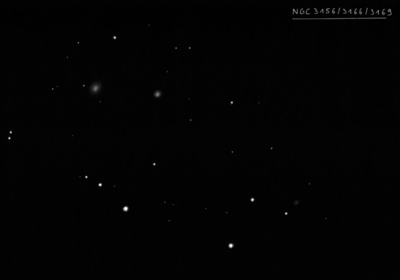
William Herschel discovered NGC 3156 = H III-255 = h680 on 13 Dec 1784 (sweep 342) and noted "vF, vS, preceding a triangle of bright stars." On 10 Apr 1828 (sweep 143) John Herschel called the galaxy, "pB; S; R: psbM; 15"."
300/350mm - 13" (4/16/83): faint, small, elongated.
400/500mm - 17.5" (3/23/85): moderately bright, small, small bright core. A triangle of bright stars follows; mag 9.0 SAO 118165 2.4' SE, mag 8.3 SAO 118168 5' ENE and mag 7.6 SAO 118169 9' SE.
Notes by Steve Gottlieb
IC 575
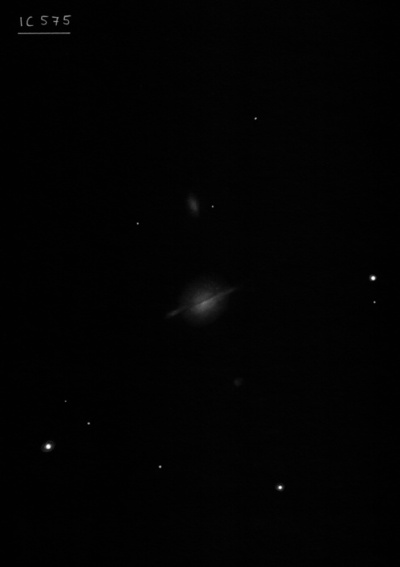
Stephane Javelle discovered IC 575 = J. 2-656, along with IC 574, on 9 Mar 1893. His micrometric position is accurate.
400/500mm - 18" (4/14/12): at 246x appeared fairly faint, fairly small, oval 4:3 NW-SE, ~28"x21", only a very weak broad concentration with no core or zones. The extensions seen in the 48" were not resolved. IC 574 lies 6' SSW.
900/1200mm - 48" (2/20/12): this unusual system has a dust lane along the major axis and a polar-ring like disc. The galaxy appears as a fairly bright oval, elongated 3:2 NW-SE, 0.6'x0.4', with a small bright core. There was only a hint of the dust lane but narrow extensions or spikes were visible poking out on the NW and SE end, with the SE extension brighter. A mag 15.2 star is 1.3' NNE and two mag 13 and 14.5 stars are 2.3' SE and 1.7' SE, respectively
There are two close companions but I only noted 2MASX J09543313-0650143 1.2' N. The observation was made during a period of fairly poor transparency and seeing so this galaxy would be worth revisiting. IC 575 is listed as a polar ring candidate in Whitmore et al "New observations and a photographic atlas of polar-ring galaxies" (1990AJ....100.1489W)
Notes by Steve Gottlieb
NGC 3047
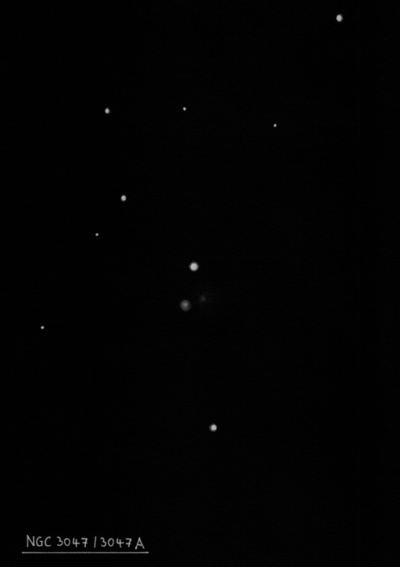
George Hough discovered NGC 3047 on 24 Apr 1883 with the 18.5-inch Clark refractor at the Dearborn Observatory and described as "small and round, very faint." Both Hough and Sherburne Burnham reobserved the galaxy on 5 May and Dreyer credited the pair. The discovery position in AN 2524 is 8 tsec W (only given to the nearest tenth of a tmin) of UGC 5323.
400/500mm - 17.5" (3/25/95): very faint, very small, round, 15" diameter, faint stellar nucleus. Located 1.3' SSE of mag 8.6 SAO 137215. Forms a double system with a very faint stellar companion (NGC 3047A) just 40" WNW of center.
Notes by Steve Gottlieb
HCG 43
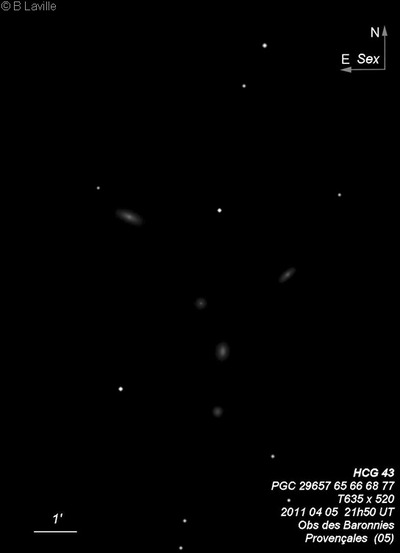
| Type | GALCL [S2] |
| RA | 10:11:13.8 |
| Dec | -00:01:54.0 |
| major_axis | 4.59' |
| mag | 12.4 |
| surface_bright | 99.9 |
Pal 3
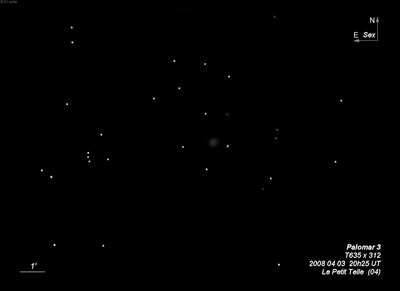
| Type | GC [XII] |
| RA | 10:05:30.0 |
| Dec | +00:04:00.0 |
| major_axis | 96.0'' |
| mag | 13.9 |
| surface_bright | 14.7 |